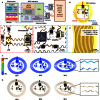Battery-free, stretchable optoelectronic systems for wireless optical characterization of the skin
- PMID: 27493994
- PMCID: PMC4972468
- DOI: 10.1126/sciadv.1600418
Battery-free, stretchable optoelectronic systems for wireless optical characterization of the skin
Abstract
Recent advances in materials, mechanics, and electronic device design are rapidly establishing the foundations for health monitoring technologies that have "skin-like" properties, with options in chronic (weeks) integration with the epidermis. The resulting capabilities in physiological sensing greatly exceed those possible with conventional hard electronic systems, such as those found in wrist-mounted wearables, because of the intimate skin interface. However, most examples of such emerging classes of devices require batteries and/or hard-wired connections to enable operation. The work reported here introduces active optoelectronic systems that function without batteries and in an entirely wireless mode, with examples in thin, stretchable platforms designed for multiwavelength optical characterization of the skin. Magnetic inductive coupling and near-field communication (NFC) schemes deliver power to multicolored light-emitting diodes and extract digital data from integrated photodetectors in ways that are compatible with standard NFC-enabled platforms, such as smartphones and tablet computers. Examples in the monitoring of heart rate and temporal dynamics of arterial blood flow, in quantifying tissue oxygenation and ultraviolet dosimetry, and in performing four-color spectroscopic evaluation of the skin demonstrate the versatility of these concepts. The results have potential relevance in both hospital care and at-home diagnostics.
Keywords: Battery-free; NFC; bio-integrated; healthcare; near-field communication; optical; optoelectronics; skin; stretchable; wireless.
Figures





References
-
- Monton E., Hernandez J. F., Blasco J. M., Hervé T., Micallef J., Grech I., Brincat A., Traver V., Body area network for wireless patient monitoring. IET Commun. 2, 215–222 (2008).
-
- Otto C., Milenković A., Sanders C., Jovanov E., System architecture of a wireless body area sensor network for ubiquitous health monitoring. J. Mobile Multimedia 1, 307–326 (2006).
Publication types
MeSH terms
Grants and funding
LinkOut - more resources
Full Text Sources
Other Literature Sources

